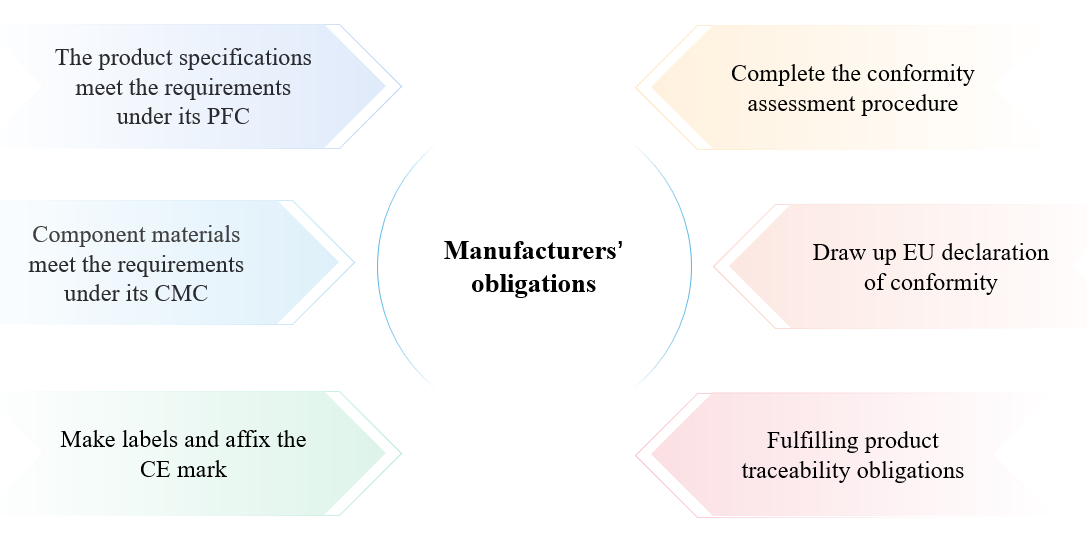On June 5, 2019, the European Commission approved and adopted the EU Fertilizer Regulation (EC) No 2019/1009, which will be officially implemented on July 16, 2022, replacing the old Regulation (EC) No 2003/2003. The regulation expands the scope of fertilizer, not only including mineral fertilizers and inorganic fertilizers, but also covering organic fertilizers, biostimulants and fertilizer made from such recycled materials. Fertilizers that meet the requirements of this regulation can be affixed with the CE mark and sold in the EU market. This Regulation should therefore not apply to products which are not CE marked when made available on the market.
PFCs and CMCs under the EU Fertilizer Regulation
According to the specific functions of fertilizer products, fertilizer products are divided into 7 categories. The regulation also regulates the raw materials used in fertilizers, and divides the raw materials into 11 categories according to their origin (Please find the details in Table 1 below). Note that the raw materials used in the production of EU fertilizers need to be registered under REACH, otherwise the fertilizer will not be approved in the EU.
Table 1 PFCs and CMCs under EU Fertilizer Regulation
Product Function Categories (PFCs) of EU fertilizing products | Component Material Categories (CMCs) |
PFC 1. Fertilizer; PFC 2. Liming material; PFC 3. Soil improver; PFC 4. Growing medium; PFC 5. Inhibitor; PFC 6. Plant biostimulant; PFC 7. Fertilizing product blend. | CMC 1: Virgin material substances and mixtures CMC 2: Plants, plant parts or plant extracts CMC 3: Compost CMC 4: Fresh crop digestate CMC 5: Digestate other than fresh crop digestate CMC 6: Food industry by-products CMC 7: Micro-organisms CMC 8: Nutrient polymers CMC 9: Polymers other than nutrient polymers CMC 10: Derived products within the meaning of Regulation (EC) No 1069/2009 CMC 11: By-products within the meaning of Directive 2008/98/EC CMC 12: Precipitated phosphate salts and derivates CMC 13: Thermal oxidation materials and derivates CMC 14: Pyrolysis and gasification materials CMC 15: Recovered high purity materials |
Data Requirement
Different conformity assessment procedures with different data requirements. Generally, applicants shall prepare a technical documentation, CE marking and EU declaration of conformity. Technical documents usually contain test reports, manufacturing processes, product descriptions, list of component materials, etc.
Furthermore, Component materials incorporated into the EU fertilizing product, on their own or in a mixture, shall have been registered pursuant to Regulation (EC) No 1907/2006, the exemption for tonnage threshold does not apply under fertilizer product regulation.
How to Register an EU Fertilizer
Based on different fertilizer product categories and raw material categories, fertilizer manufacturers need to complete different conformity assessment procedures. The conformity assessment procedures are divided into 4 categories, Module A, Module A1, Module B+C and Module D1 (Please find the details in Table 2 below). Except for Module A, fertilizer manufacturers should prepare relevant technical materials and apply for registration under other three conformity assessment procedures. And they need to be evaluated by a Notified Body accredited by the European Union. If the notified body determines that the fertilizing product has met all the relevant requirements, it will issue a certificate to the fertilizer product.
Table 2 Module type for different types of fertilizers
Module type | Fertilizer products required to comply with the modules | |
Module A | Internal product control | EU fertilizer composed of the following materials: CMC 1 expect 1(4) and CMCs 4, 6, 8 and 11. PFC 7 |
Module A1 | Internal production control plus supervised product testing | Ammonium nitrate fertilizer of high nitrogen content |
Module B+C | EU type examination followed by Module C – conformity to type based on internal production control | EU fertilizer composed of the following materials: CMC 1 containing CMC 1(4), CMCs 2, 4, 6, 8, 9, 10 and 11. PFC 7 |
Module D | Quality assurance of the production process | Any EU fertilizer product expect ammonium nitrate fertilizer of high nitrogen content. |
Manufacturers’obligations
When an enterprise needs to sell CE-marked fertilizer products in the EU market, it not only needs to register the product according to EU fertilizer regulations, but also needs to conduct retrospective supervision on the product after product registration. There are some key points enterprises need to pay attention to when comply with the fertilizer regulation.
1. Manufacturers shall specify which product type the product belongs to, and ensure that the content of nutrients or pollutants in the product meets the limit requirements.
2. REACH registration is required for some component materials categories.
3. Manufacturers need to draw up technical documents, product labels and EU declaration of conformity to complete the conformity assessment procedure, also shall keep these documentations for 5 years after the EU fertilizing product covered by those documents has been placed on the market.
4. Ensure traceability of the EU fertilizing product to facilitate authorities’ market supervision.





